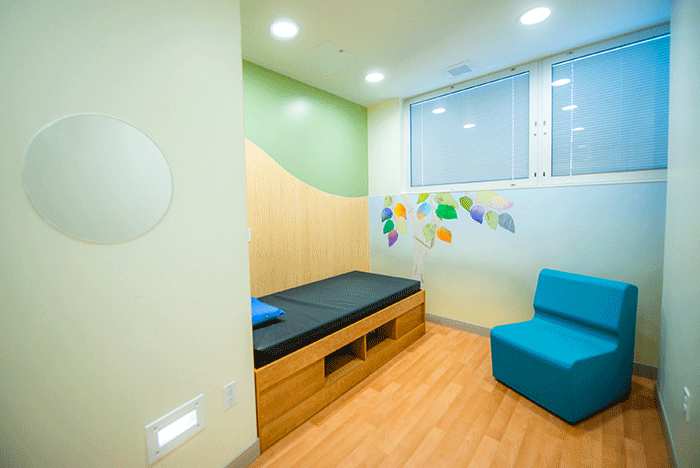Facilities that support behavioral health care
One of the most sensitive topics in health care is behavioral care, and the conversation around design of these spaces is no different. Two goals are often at the center of current care models for behavioral health: safety and healing.
The Center for Health Design’s Knowledge Repository includes several papers focused on a trend toward more therapeutic environments for behavioral health settings. Three recent studies focusing on design for behavioral care are highlighted here.
In a paper out of Norway by Faerden and colleagues, the authors discuss the importance of supporting a sense of dignity. The authors describe how, historically, “seclusion” has taken place in sparsely furnished, locked white rooms or units. This study used a “service design” approach, focusing on the user experience to inform design for a renovation.
The researchers surveyed psychiatric staff regarding their experience in providing care with dignity. Reflecting the current trend toward comfort rooms versus seclusion, findings included themes such as a welcoming, calm and quiet atmosphere, with access to nature and privacy, and opportunities for social activities and close contact with staff.
Another study, conducted at a psychiatric hospital in the Netherlands, comes from Sturge and Starrenburg. The team examined lessons learned from the COVID-19 pandemic regarding design of future behavioral health environments. An interdisciplinary team met throughout the first 18 months of the pandemic to reflect on how design could better support the safe provision of care in a new facility.
One finding of interest is the temporary use of seclusion rooms as an isolation precaution for infection control, as psychiatric hospitals do not typically have infection-related isolation rooms. Seclusion rooms were modified to keep the doors open so patients could move around while limiting transmission among patients and staff. Results of the study include the inevitable trade-offs and opportunities when trying to prioritize both therapeutic and infection prevention goals in psychiatric care.
Designers must always balance multiple priorities. Building on prior research for an evaluation framework, a study by Shepley and colleagues assesses the difference between importance and effectiveness of features in three U.S.-based inpatient behavioral health facilities. The researchers explain that while a design strategy might achieve a certain goal (i.e., it’s effective), it should also be something that actually matters to users (i.e., it’s important). Mitigating suicide risk was found to be one of the most important qualities of the environment for both staff and residents. Interestingly, there was a statistically significant difference between what staff rated as important versus what they felt was effective, but there was no difference according to residents.
If you are interested in evidence-based design strategies in this setting, you may want to check out The Center for Health Design’s Interactive Design Diagrams, including a Therapeutic ED Treatment Room and an Inpatient Behavioral and Mental Health Room.
To read more on designing for psychiatric care and other topics, please visit The Center for Health Design’s Knowledge Repository.
Research used for this column
The following research citations from The Center for Health Design’s Knowledge Repository of health care design resources were used by the author when writing this column:
- A. Faerden et al., “Environmental Transformations Enhancing Dignity in an Acute Psychiatric Ward: Outcome of a User-Driven Service Design Project,” HERD: Health Environments Research & Design Journal, 2022, in press.
- J. Sturge and F. Starrenburg, “The Reorganization of a Psychiatric Unit during COVID-19: A Reflection for Psychiatric Hospital Design,” HERD: Health Environments Research & Design Journal, vol. 15, no. 4 (2022): 354–68.
- M. M. Shepley et al., “Staff and Resident Perceptions of Mental and Behavioural Health Environments,” Building Research & Information, vol. 50, no. 1–2 (2022): 89–104.
About this column
“Design Discoveries” highlights research from The Center for Health Design’s Knowledge Repository, a user-friendly library of health care design resources. This research effort is supported by the American Society for Health Care Engineering, the American Institute of Architects, the Academy of Architecture for Health Foundation and the Facility Guidelines Institute.
Melissa Piatkowski, research associate, The Center for Health Design.


